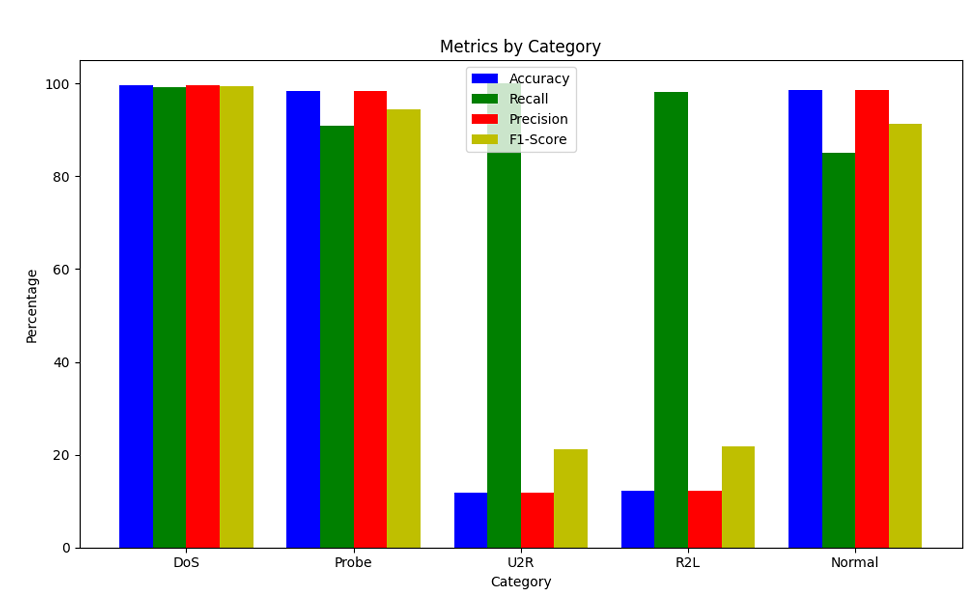Hybrid Intrusion Detection System Based on Optimal Feature Selection and Evolutionary Algorithm for Wired Networks
Keywords:
Intrusion Detection System, Ant Colony Optimization, Feature Selection, High-Dimensional Data, Weighted Stacking ClassifierAbstract
The field of cybersecurity encounters ongoing difficulties in identifying and preventing attacks in networks, and the pervasive threat of cyberattacks demands continual advancements in intrusion detection systems (IDS) to safeguard network integrity. Traditional intrusion detection systems face the challenge of class imbalance. Addressing the formidable challenges posed by class imbalance and high-dimensional data, this research proposes a novel hybrid IDS approach. Leveraging (ACO), the algorithm navigates complex datasets to identify salient features, effectively mitigating the complexities associated with high-dimensional data. Subsequently, a Weighted Stacking Classifier amalgamates the strengths of Random Forest, AdaBoost, and Gradient Boosting classifiers, fortifying the system’s ability to handle class imbalance robustly. By strategically enhancing the importance of base classifiers with favourable training outcomes and diminishing the influence of those yielding inferior results, the hybrid IDS endeavors to optimize classification efficacy. The experimentation, conducted exclusively on the dataset named NSL-KDD, demonstrates the efficacy of the proposed model, yielding remarkable results. With a 90.13% Accuracy, 88.87% precision, 91.23% Recall, and 87.33% F1-score, the hybrid IDS exhibits superior performance in detecting malicious activity. The findings underscore the viability of the proposed hybrid IDS as a potent tool in the ongoing battle against cyber threats, positioning it for real-world deployment across diverse networks.
References
R. Fotohi and S. Firoozi Bari, “A novel countermeasure technique to protect WSN against denial-of-sleep attacks using firefly and Hopfield neural network (HNN) algorithms,” J. Supercomput., vol. 76, no. 9, pp. 6860–6886, Sep. 2020, doi: 10.1007/S11227-019-03131-X/METRICS.
Hasson and Timothy, “Bad bot report 2021,” Imperva, 2021, [Online]. Available: https://www.imperva.com/blog/bad-bot-report-20 21-the-pandemic-of-the-internet/
İ. N. A. Ahmet Efe, “Comparison of the Host Based Intrusion Detection Systems and Network Based Intrusion Detection Systems,” Celal Bayar Univ. J. Sci., vol. 18, no. 1, 2022, doi: https://doi.org/10.18466/cbayarfbe.832533.
A. A. Alqarni, “Toward support-vector machine-based ant colony optimization algorithms for intrusion detection,” Soft Comput., vol. 27, no. 10, pp. 6297–6305, May 2023, doi: 10.1007/S00500-023-07906-6/METRICS.
M. Yuyang Zhou, Guang Cheng , Shanqing Jiang, Dai, “Building an efficient intrusion detection system based on feature selection and ensemble classifier,” Comput. Networks, vol. 174, p. 107247, 2020, doi: https://doi.org/10.1016/j.comnet.2020.107247.
P. B. S. Vanitha, “Improved Ant Colony Optimization and Machine Learning Based Ensemble Intrusion Detection Model,” Intell. Autom. Soft Comput., vol. 36, no. 1, pp. 849–864, 2023, doi: https://doi.org/10.32604/iasc.2023.032324.
Z. G. and J. W. C. Liu, “A Hybrid Intrusion Detection System Based on Scalable K-Means+ Random Forest and Deep Learning,” IEEE Access, vol. 9, pp. 75729–75740, 2021, doi: 10.1109/ACCESS.2021.3082147.
M. T. I. R. Md. Rayhan Ahmed , salekul Islam ,Swakkhar Shatabda ,A. K. M. Muzahidul Islam, “Intrusion Detection System in Software-Defined Networks Using Machine Learning and Deep Learning Techniques --A Comprehensive Survey,” Commun. Netw. Broadcast Technol., 2021, doi: 10.36227/techrxiv.17153213.v1.
J. Snehi, A. Bhandari, V. Baggan, and M. Snehi, “Diverse Methods for Signature based Intrusion Detection Schemes Adopted,” Int. J. Recent Technol. Eng., vol. 9, no. 2, pp. 44–49, Jul. 2020, doi: 10.35940/IJRTE.A2791.079220.
D. H. W. Smys Smys, Dr. Abul Basar, “Hybrid Intrusion Detection System for Internet of Things (IoT),” J. ISMAC, vol. 2, no. 4, pp. 190–199, 2020, doi: 10.36548/jismac.2020.4.002.
P. A. Osanaiye Opeyemi, Ogundile Olayinka, Aina Folayo, “Feature selection for intrusion detection system in a cluster-based heterogeneous wireless sensor network,” Facta Univ. - Ser. Electron. Energ., vol. 32, no. 2, pp. 315–330, 2019, doi: https://doi.org/10.2298/FUEE1902315O.
B. Y. Neelu Khare, Preethi Devan, Chiranji Lal Chowdhary, Sweta Bhattacharya, Geeta Singh, Saurabh Singh, “SMO-DNN: Spider Monkey Optimization and Deep Neural Network Hybrid Classifier Model for Intrusion Detection,” Electronics, vol. 9, no. 4, p. 692, 2020, doi: https://doi.org/10.3390/electronics9040692.
M. Catillo, M. Rak, and U. Villano, “2L-ZED-IDS: A Two-Level Anomaly Detector for Multiple Attack Classes,” Adv. Intell. Syst. Comput., vol. 1150 AISC, pp. 687–696, 2020, doi: 10.1007/978-3-030-44038-1_63.
Q. R. S. Fitni and K. Ramli, “Implementation of ensemble learning and feature selection for performance improvements in anomaly-based intrusion detection systems,” Proc. - 2020 IEEE Int. Conf. Ind. 4.0, Artif. Intell. Commun. Technol. IAICT 2020, pp. 118–124, Jul. 2020, doi: 10.1109/IAICT50021.2020.9172014.
P. Vaid, S. K. Bhadu, and R. M. Vaid, “Intrusion detection system in Software defined Network using machine learning approach - Survey,” Proc. 6th Int. Conf. Commun. Electron. Syst. ICCES 2021, pp. 803–807, Jul. 2021, doi: 10.1109/ICCES51350.2021.9489141.
C. Wang, X., Qiao, Y., Xiong, J., Zhao, Z., Zhang, N., Feng, M., & Jiang, “Advanced Network Intrusion Detection with TabTransformer,” J. Theory Pract. Eng. Sci., vol. 4, no. 3, pp. 191–198, 2024, doi: https://doi.org/10.53469/jtpes.2024.04(03).18.
L. D’hooge, T. Wauters, B. Volckaert, and F. De Turck, “Inter-dataset generalization strength of supervised machine learning methods for intrusion detection,” J. Inf. Secur. Appl., vol. 54, p. 102564, 2020, doi: https://doi.org/10.1016/j.jisa.2020.102564.
S. K. Yakubu Imrana, Yanping Xiang , Liaqat Ali, Zaharawu Abdul-Rauf, Yu-Chen Hu, “χ 2-BidLSTM: A Feature Driven Intrusion Detection System Based on χ 2 Statistical Model and Bidirectional LSTM,” Sensors (Basel), vol. 22, no. 5, 2022, [Online]. Available: https://pubmed.ncbi.nlm.nih.gov/35271164/
R. Chowdhury, A. Roy, B. Saha, and S. K. Bandyopadhyay, “A Step Forward to Revolutionize Intrusion Detection System Using Deep Convolutional Neural Network,” Data-driven Ind. Comput. Springer, Singapore, pp. 337–352, 2021, doi: 10.1007/978-981-15-9873-9_27.
Muhammad Ashfaq Khan, “HCRNNIDS: Hybrid Convolutional Recurrent Neural Network-Based Network Intrusion Detection System,” Processes, vol. 9, no. 5, p. 834, 2021, doi: https://doi.org/10.3390/pr9050834.
G. Candea and B. Plattner, “Nsl-kdd data set,” Kaggle, 2003, [Online]. Available: https://www.kaggle.com/datasets/hassan06/nslkdd
L. Z. and X. W. R. Zhao, Y. Mu, “A Hybrid Intrusion Detection System Based on Feature Selection and Weighted Stacking Classifier,” IEEE Access, vol. 10, pp. 71414–71426, 2022, doi: 10.1109/ACCESS.2022.3186975.

Downloads
Published
How to Cite
Issue
Section
License
Copyright (c) 2025 50sea

This work is licensed under a Creative Commons Attribution 4.0 International License.




















